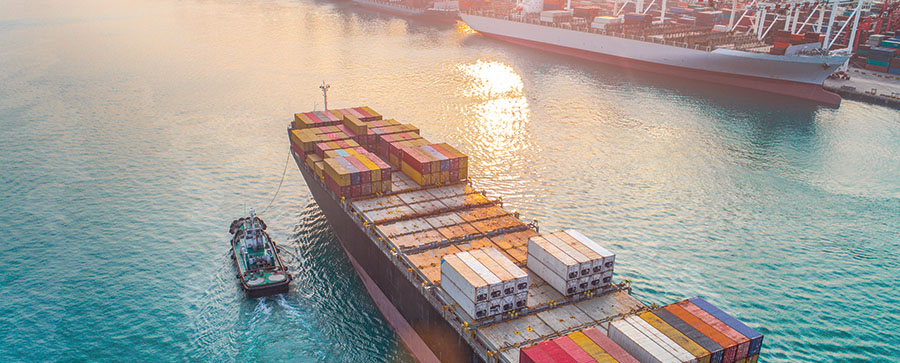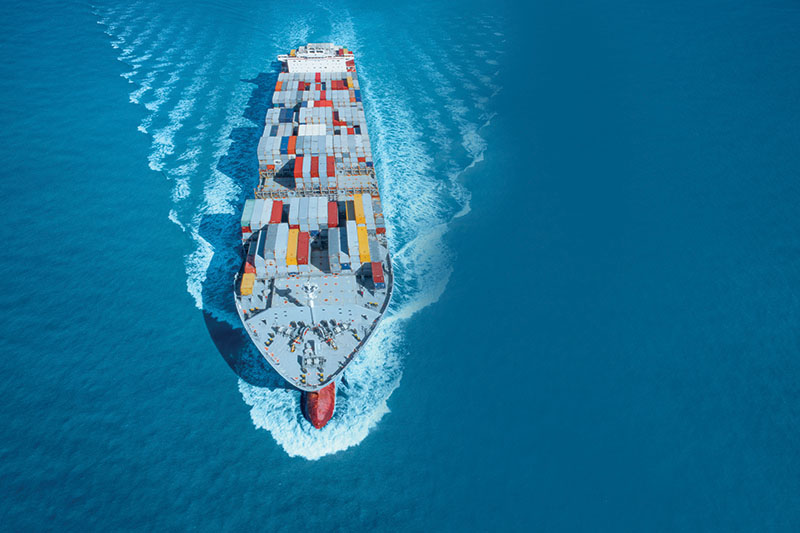State of Ocean Cargo: New costs, consultation to burden fleet owners
As if the newly imposed IMO 2020 fuel standards and greenhouse gas emissions reduction discussions weren’t enough, carriers now face fresh costs related to maintenance and insurance heading into the post-COVID era.
Now that the IMO 2020 fuel sulphur regulation is firmly in place along with new discussions about what to do next to reduce greenhouse gas emissions, carriers find themselves back on their heels.
“The environmental profile of ocean carriers is critical today for a host of interconnected reasons, including social responsibility, shipper requirements, long-term business planning, regulatory certainty, and operational safety,” notes John Butler, president and CEO of the World Shipping Council.
Yet, cost is also a necessary conversation, says Butler, because they have to play out in the marketplace among fuel suppliers, carriers, and shippers. “When you add that broad operational and geographic scope to the cost impact, it’s obvious that there isn’t a level playing field,” he says. “The key to keeping the playing field level is for IMO member countries to be very clear and very public in reminding the industry that compliance will be required for everyone.”
Furthermore, Butler says, national governments have to follow up to make sure that vessels flying their flags and calling their ports are obeying the law. “However, the sulphur rules and their expected costs do factor into the business case for making a major push to find the next generation of marine fuels,” he adds. “That connection is that the industry is continually faced with new and more costly regulations associated with the burning of fossil fuels.”
According to Butler, there’s a high probability that whatever fuels end up replacing fossil fuels for shipping will have a related benefit of reducing or eliminating many of the air pollutants associated with fossil fuels that the supply chain is increasingly paying to mitigate. “That means that there’s a direct business case that supports finding the fuels of the future as soon as we can identify alternatives that are safe, operationally realistic and commercially viable,” he concludes.

Fuel volatility
Meanwhile, even before the COVID-19 outbreak, the world had been going through a “synchronized slowdown” with lower GDP growth toward the end of 2019, alongside rising trade barriers that had a major impact on the container shipping market, says Peter Sand, chief shipping analyst for the Baltic and International Maritime Council (BIMCO) in Copenhagen.
“Considerable cost pressure remains despite some of the trade war damage being offset by a reshuffling of manufacturing in Asia,” says Sand. “Adding to this pressure is bunker price volatility.”
Sand notes that in recent decades, the carriers have experimented with bunker adjustment factors (BAFs), an additional fuel surcharge, in order to mitigate some of the bunker price volatility. However, the implementation of BAFs has often been received with mixed results, to “non-transparency.”
BIMCO believes that the ongoing slowing of container volume growth could result in more cutthroat competition among the carriers for container volumes. “If carriers end up in a competition of undercutting each other, the probability of implementing BAFs will certainly be decreased significantly,” says Sand.
A plethora of uncertain variables lie ahead, BIMCO believes. Fuel oil availability, compatibility, and price levels are all variables that will be closely followed in the months to come. Seemingly, the oil price fluctuations are no longer driven by fundamentals, but instead dictated by market uncertainty and speculation. A widening spread could have dire consequences for some owners, whereas others would be in a much more advantageous position.
“No matter the outcome, IMO sulphur regulation will entail higher expenses for the industry,” Sand concludes. “Owners hoping to pass on the costs associated with the regulation might have a difficult time doing so if the underlying market fundamentals are not balanced.”
Insurance woes
The existing money problems that carriers are now facing are simply exacerbated by higher insurance rates as well as repair and maintenance spending, say analysts for Drewry Supply Chain Advisors in the new report “Ship Operating Costs Annual Review and Forecast 2020.”
According to Drewry analysts, 2019 was the third consecutive year in which costs had risen following marked declines in operating expense during the “capacity ravaged” years of 2015-16. Now, analysts estimate that average daily operating costs will increase by as much as 2.2% in 2020.
In the most recent rise, Drewry notes that spending rose across all six of the main cost categories, indicating how broad-based inflation continues to exist across the board. That cost-inflation curve has been dampened slightly by a continued recovery across most cargo shipping markets.
“While cost pressures remain, this trend confirms the end of the deflationary era that prevailed mid-decade, as the depressed state of shipping markets forced operators to slash costs in order to survive,” says Martin Dixon, Drewry’s director of research products.
Heading into the New Year, market conditions are expected to be challenging for many shipowners as the trade outlook remains uncertain and benign capacity conditions prove temporary when the current round of retrofits recedes. As a consequence, Dixon expects the pressure on costs to remain, which will dampen any likely inflation, particularly in areas where owners have greater control—such as manning, stores, spares, and management and administration.
“Other cost heads, beyond the direct control of shipowners, will prove tougher to manage, particularly insurance where we expect costs to rise sharply in 2020,” adds Dixon. “Continued attempts to clean up and decarbonize shipping will add to owner cost burdens, affecting management and administration, repair and maintenance, and dry docking costs in particular, as retrofitted equipment adds to maintenance costs.”
Slow recovery
Amid the flurry of ocean carrier consolidation earlier in the past decade, global business sentiment took a hard hit, say analysts for JPMorgan Global PMI compiled by IHS Markit.
“If the demand slowdown would have happened a few years earlier, the impact on the container carriers would have been catastrophic,” says Rahul Kapoor, head of research and analytics in the maritime and trade business of IHS Markit. “But one of the greatest consolidation events in the container shipping industry is shielding them from that impact. We’re seeing very strong capacity discipline by the carriers, and in turn expect the volatility to subside and annual freight rate escalations to cement.”
Can digitization speed ocean carrier recovery?
Since its governance model has won the approval of the Federal Maritime Commission at this time last year, The New York Shipping Exchange (NYSHEX) has helped the ocean carrier industry move to a collaborative platform.
The latest development was when the alliance, ONE, joined the other groups of carriers who use NYSHEX to offer shippers the ability to enter digital and mutually enforceable contracts.
With seven of the leading global ocean carriers now on NYSHEX, over 60% of global capacity is represented. The member carriers also represent all three
container shipping alliances—2M, Ocean Alliance and THE Alliance—providing NYSHEX shipper members a broad array of service options to choose from.
According to Sundeep Sibal, senior vice president of trans-Pacific and trans-Atlantic trade at ONE, says NYSHEX will enable them to offer shippers an additional point of contact, whereby the agreed rates and service terms are mutually enforceable. “The guaranteed equipment, space and price that we offer through NYSHEX will help our shippers to plan their supply chain and to lock in their transport costs up front,” he adds.
According to spokesmen, digital contracts made through NYSHEX have achieved a fulfillment rate of 98.4%, substantially improving reliability for both shippers as well as carriers.
Furthermore, ONE’s membership comes at a time when NYSHEX is expanding the services it offers. Currently, the NYSHEX system supports more customizable terms that form part of the digital and enforceable contracts. For example, where the shipper and carrier agree, contracts will be able to cater to multiple origins and destinations, as well as longer “validities.”
- Patrick Burnson, executive editor
According to IHS Markit, the remaining carriers are increasingly acting to control their own destiny by more effectively controlling capacity through restraint in ship ordering and by more actively managing spot capacity through blanked sailings.
“This is a fundamental shift that some believe could be permanent,” says Kapoor. “Simply put, this means the year-over-year reductions in rates that many shippers enjoyed for years is likely coming to an end. Instead, shippers are looking at a future of higher rates, a change that will take some getting used to.”
Dan Smith, a principal at freight consultancy The Tioga Group, is among the many industry analysts who are concerned about excess tonnage. “As long as overcapacity exists, the question is not how much it costs to operate the vessels, but how much they can recover from shippers who have multiple options,” he says.
Panjiva research director Chris Rogers certainly agrees, noting that consolidation may be one important route to improved profitability. “The container-lines’ consolidation is already done,” he says. “The top 10 liners represented 87.4% of U.S. inbound shipping in 2019, but in the freight forwarder sector the ratio is just 14.1%,” he says.
However, Rogers also observes that while container line profitability improved in the fourth quarter of 2019 to an 11.1% EBITDA margin, that included a benefit from lease accounting changes at Maersk and Hapag-Lloyd and only leaves the ratio at third quarter 2017 levels. “The shipping industry may therefore need to cut costs,” he adds, “yet, cutting headcount to compensate could generate labor unrest.”
According to Mirko Woitzik, EMEA risk intelligence manager at DHL Resilience360, the main worry for global shippers revolves around fewer providers. “There remain only a limited number of large targets for further consolidation among the biggest container shipping lines in the ocean industry,” he says. “Most of the big players are now linked up in a global shipping alliances or have government ties, making them unlikely takeover targets outside their home nations.”
Finally, Woitzik adds, there’s also likely to be more regulatory scrutiny should there be another large-scale merger or acquisition. “To be realistic, logistics managers should understand that the potential candidates for further consolidation are likely to be found in regional or niche carriers that own less than 1% of the global containership fleet.”

Article Topics
Ocean Freight News & Resources
Descartes March Global Shipping Report highlights ongoing steady volume momentum U.S.-bound import growth track remains promising, notes Port Tracker report Nimble shippers coping with Baltimore port closing by shifting plans Q&A: Port of Oakland Maritime Director Bryan Brandes Signs of progress are being made towards moving cargo in and out of Baltimore Industry experts weigh in on Baltimore bridge collapse and subsequent supply chain implications Expensive, lengthy delays expected before Port of Baltimore can re-open to vessels following Key Bridge collapse More Ocean FreightLatest in Logistics
LM Podcast Series: Assessing the freight transportation and logistics markets with Tom Nightingale, AFS Logistics Investor expectations continue to influence supply chain decision-making The Next Big Steps in Supply Chain Digitalization Warehouse/DC Automation & Technology: Time to gain a competitive advantage The Ultimate WMS Checklist: Find the Perfect Fit Under-21 driver pilot program a bust with fleets as FMCSA seeks changes Diesel back over $4 a gallon; Mideast tensions, other worries cited More LogisticsAbout the Author
Subscribe to Logistics Management Magazine

Find out what the world's most innovative companies are doing to improve productivity in their plants and distribution centers.
Start your FREE subscription today.
April 2023 Logistics Management

Latest Resources
















